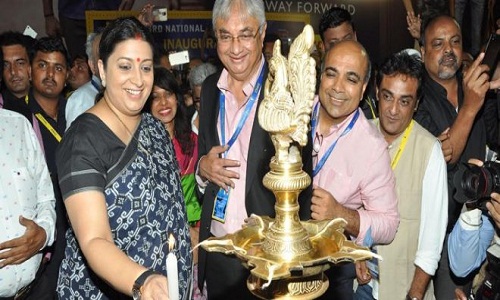"The government has announced a package of measures for the textiles and the garment industries. The notification says, the package is labour friendly and would promote employment generation, economies of scale and boost exports. The government expects that in the next three years it will generate 10 million jobs in the two industries and lead to a cumulative increase of $30 billion in exports and investment of Rs 74,000 crore. "

The government has announced a package of measures for the textiles and the garment industries. The notification says, the package is labour friendly and would promote employment generation, economies of scale and boost exports. The government expects that in the next three years it will generate 10 million jobs in the two industries and lead to a cumulative increase of $30 billion in exports and investment of Rs 74,000 crore. Official statistics say, 70 per cent of the workers in the garment industry are women and, therefore, the anticipated boost to employment, in the government’s view, will help in social transformation through women’s empowerment.
Exports get a boost

The enhanced duty drawback scheme, which, for the first time, will refund the levies imposed by the state governments as well, is the most important component of this package. Yet another significant component of the package is the increase in subsidy under the Technology Utilisation Fund Scheme (TUFS), which was amended in December 2015. Interestingly, the basis of the increase in subsidy has been changed from input to outcome; in other words, the subsidies will be disbursed only after the expected additional jobs are created. The annual budgetary support required for this new addition to the duty drawback measures is estimated at Rs 6,000 crore, the bulk of which would be expended through the duty drawback scheme. This additional spending would appear minuscule, given that the government expects garment exports to increase annually by more than 60 per cent over their 2015-16 level of more than Rs 1,10,000 crore over the next three years. Besides, the package would augment jobs in an industry that was the third-largest employer among the major industry groups in 2013-14, reports the Annual Survey of Industries.
The justification for supporting the textiles and the garment industries is compelling, and this can be better understood from two perspectives. The first is that this sector was a major foreign-exchange earner for India until the turn of the millennium, accounting for well over a quarter of the country’s export earnings. Over the next decade, the relative importance of the sector declined rapidly, and by 2011, exports of textiles and garments were just 11 per cent of India’s total outgo.
The decline in India’s presence in the global markets is the second perspective. For over the past couple of decades, India has been struggling to retain its place as a major exporter. India was once a key player in the international marketplace, and against its prowess the major economies had progressively imposed, with the full sanction of the multilateral trading system, higher levels of quota restrictions to limit the entry of its products. Alongside the decision to establish the World Trade Organization (WTO), an agreement was also reached to remove the quotas, which were eventually eliminated at the beginning of 2005. There were huge expectations that the quota removal would provide the much-needed incentives for the textiles and the garment sectors to improve their positions.
Mixed results
The textiles sector has seen a definite improvement among the major exporters, but the garments sector’s position has worsened. In the year 2000, India was not even on the list of the 10 largest exporters, having a share of just over 3 per cent of the global trade in textiles, and by 2014, India’s share had increased to almost 6 per cent and it was the third-largest exporter.
On the other hand, India’s garments exports have been lagging behind the country’s major competitors by quite some distance. In 2000, India’s share was 3 per cent and it was the ninth-largest exporter. After nearly a decade and a half, its share was still below 4 per cent. But while India’s share barely moved, Bangladesh and Vietnam were able to enhance their respective positions as suppliers of garments. Bangladesh had doubled its share in the global market, from 2.6 per cent in 2000 to more than 5 per cent in 2014, while Vietnam increased its share from less than 1 per cent to 4 per cent. One other issue that must be considered while making an assessment of the relative position of India is the China factor. Both the textiles and garment markets were overwhelmingly dominated by China. China’s share in textiles exports was nearly 36 per cent in 2014, up from 10 per cent in the year 2000; while its share in garment exports was even higher at 39 per cent, up from 18 per cent.
Focus on revival
The government needs to reflect as to whether the recent package of incentives is adequate for making Indian players more competitive in the global markets, given the huge gulf between India and the other leading players, in both textiles and garments. For quite some time now, there has been evidence aplenty that India’s textiles and garments industries lack the sinews to compete in the global markets. Successive governments have been mindful of this problem and have taken measures.
The government will have to find ways of ensuring that the shop-floor efficiencies of the two industries are taken to distinctly higher levels through concerted efforts of technology infusion, as it is focusing on the revival of the textiles and the garments industries. The capabilities of domestic machinery manufacturers need to be harnessed, for these entities can provide the solutions that the small firms in the textiles and garments sectors need urgently.












